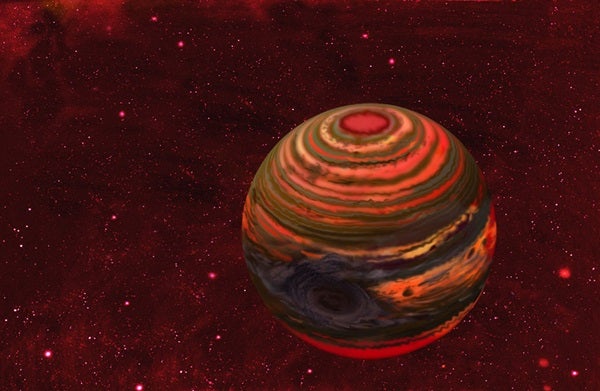As part of a large survey of nearby brown dwarfs — objects that occupy the mass gap between dwarf stars and giant planets — the scientists used an infrared camera on the 2.5-meter telescope at Las Campanas Observatory in Chile to capture repeated images of a brown dwarf dubbed 2MASS J21392676+0220226 (2MASS 2139) over several hours. In that short time span, they recorded the largest variations in brightness ever seen on a cool brown dwarf.
“We found that our target’s brightness changed by a whopping 30 percent in just under 8 hours,” said Jacqueline Radigan from the University of Toronto, Canada. “The best explanation is that brighter and darker patches of its atmosphere are coming into our view as the brown dwarf spins on its axis.”
“We might be looking at a gigantic storm raging on this brown dwarf, perhaps a grander version of the Great Red Spot on Jupiter in our own solar system, or we may be seeing the hotter, deeper layers of its atmosphere through big holes in the cloud deck,” said Ray Jayawardhana from the University of Toronto.
According to theoretical models, clouds form in brown dwarf and giant planet atmospheres when tiny dust grains made of silicates and metals condense. The depth and profile of 2MASS 2139’s brightness variations changed over weeks and months, suggesting that cloud patterns in its atmosphere are evolving with time.
“Measuring how quickly cloud features change in brown dwarf atmospheres may allow us to infer atmospheric wind speeds eventually and teach us about how winds are generated in brown dwarf and planetary atmospheres,” Radigan said.
As part of a large survey of nearby brown dwarfs — objects that occupy the mass gap between dwarf stars and giant planets — the scientists used an infrared camera on the 2.5-meter telescope at Las Campanas Observatory in Chile to capture repeated images of a brown dwarf dubbed 2MASS J21392676+0220226 (2MASS 2139) over several hours. In that short time span, they recorded the largest variations in brightness ever seen on a cool brown dwarf.
“We found that our target’s brightness changed by a whopping 30 percent in just under 8 hours,” said Jacqueline Radigan from the University of Toronto, Canada. “The best explanation is that brighter and darker patches of its atmosphere are coming into our view as the brown dwarf spins on its axis.”
“We might be looking at a gigantic storm raging on this brown dwarf, perhaps a grander version of the Great Red Spot on Jupiter in our own solar system, or we may be seeing the hotter, deeper layers of its atmosphere through big holes in the cloud deck,” said Ray Jayawardhana from the University of Toronto.
According to theoretical models, clouds form in brown dwarf and giant planet atmospheres when tiny dust grains made of silicates and metals condense. The depth and profile of 2MASS 2139’s brightness variations changed over weeks and months, suggesting that cloud patterns in its atmosphere are evolving with time.
“Measuring how quickly cloud features change in brown dwarf atmospheres may allow us to infer atmospheric wind speeds eventually and teach us about how winds are generated in brown dwarf and planetary atmospheres,” Radigan said.










